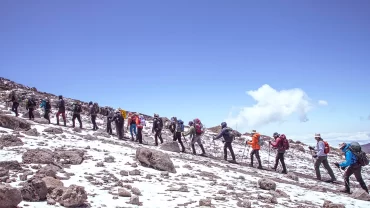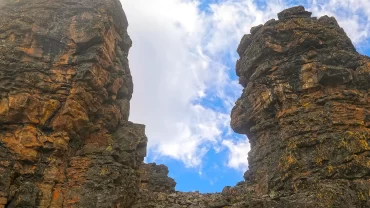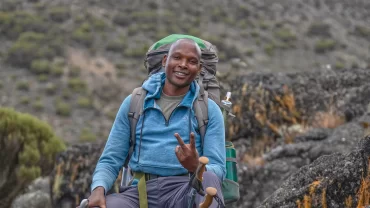Mount Kilimanjaro, the highest peak in Africa, is a majestic and iconic mountain that attracts adventurers from all over the world. Standing at 5,895 meters (19,341 feet) above sea level, it is the tallest free-standing mountain on Earth, rising dramatically from the plains of Tanzania. The mountain’s diverse climate zones, ranging from lush rainforests to barren arctic landscapes, create an otherworldly trekking experience. Each section of the climb offers breathtaking scenery, making Kilimanjaro one of the most photogenic mountains in the world.
For photographers, Kilimanjaro presents an unrivaled opportunity to capture a variety of landscapes, wildlife, and stunning natural contrasts. Whether you’re a professional photographer looking for the perfect shot or an adventurer wanting to document your journey, the mountain offers countless picture-perfect moments. From misty rainforests teeming with wildlife to the icy glaciers at the summit, Kilimanjaro is a dream destination for anyone with a camera in hand. Below are the best photo spots on Kilimanjaro that will leave you with unforgettable images of this legendary peak.
1. The Rainforest Zone: A Lush Green Start
The journey begins in the rainforest zone, where towering trees and dense foliage create a mystical atmosphere. This region is rich in wildlife, offering opportunities to capture playful blue monkeys, colobus monkeys, and a variety of exotic birds. The mist and soft light filtering through the forest canopy make for dramatic and atmospheric shots.
2. Shira Plateau: Endless Views of the Mountain
At higher altitudes, the vegetation gives way to the vast, open landscapes of the Shira Plateau. This area offers panoramic views of the mountain with a backdrop of rugged terrain and distant clouds. The best time to capture stunning images here is during sunrise or sunset when the golden hues enhance the dramatic scenery.
3. Lava Tower: Dramatic Rock Formations
Lava Tower is a towering volcanic rock formation that stands at 4,600 meters (15,091 feet). The jagged cliffs and unique geological structures make for striking images. The interplay of shadows and sunlight on the dark volcanic rock creates a dramatic effect, perfect for capturing the raw power of Kilimanjaro’s volcanic past.
4. Barranco Wall: A Photographer’s Dream
One of the most famous landmarks on Kilimanjaro, the Barranco Wall, offers an exciting challenge for climbers and an incredible subject for photographers. The steep ascent, combined with the sweeping valley below, provides a chance to capture both the scale of the mountain and the determination of climbers making their way up the wall.
5. Karanga Valley: Where Clouds Meet the Mountain
The Karanga Valley is known for its surreal scenery, where trekkers often find themselves walking through clouds. The swirling mist creates an ethereal, dreamlike setting that is perfect for dramatic landscape photography. Capturing the transition between the lower vegetation and the barren upper slopes is a must for any Kilimanjaro photo collection.
6. Barafu Camp: Sunset and Night Photography
Perched high on the mountain, Barafu Camp is the final resting point before the summit push. This location provides breathtaking views of the horizon, with the chance to capture a stunning sunset above the clouds. At night, the lack of light pollution makes Barafu an ideal spot for astrophotography, allowing for clear shots of the Milky Way stretching across the sky.
7. Stella Point: The Pre-Summit Reward
Just below Uhuru Peak, Stella Point offers climbers their first real view of the summit. The excitement and exhaustion of trekkers reaching this point make for incredible emotional portraits. The landscape here is raw and rugged, with the golden light of sunrise casting a warm glow over the summit ridge.
8. Uhuru Peak: The Ultimate Summit Shot
The crowning moment of the Kilimanjaro climb is reaching Uhuru Peak. The famous wooden sign marking the highest point in Africa is a must-photograph location. Here, climbers capture their victory poses, surrounded by breathtaking glaciers and an endless horizon above the clouds.
9. The Kilimanjaro Glaciers: Vanishing Beauty
Kilimanjaro’s glaciers are one of the most iconic yet rapidly disappearing features of the mountain. The ice formations create an astonishing contrast against the dark volcanic rock and deep blue sky. Photographers are encouraged to document these glaciers while they still exist, as climate change continues to diminish them each year.
10. The Descent: Final Panoramic Views
Descending Kilimanjaro offers a different perspective of the trek. Looking back at the mountain, especially during sunrise or sunset, provides some of the most breathtaking panoramas. The changing colors of the landscape as you move down through the climate zones make for dynamic and stunning shots.
Conclusion
Kilimanjaro is a paradise for photographers, offering a variety of landscapes, lighting conditions, and unique moments to capture. Whether it’s the rich biodiversity of the rainforest, the towering glaciers, or the rewarding summit shot at Uhuru Peak, the best photo spots on Kilimanjaro provide endless opportunities for breathtaking photography. As you embark on this incredible journey, be sure to have your camera ready—every step of the way is a chance to capture something truly unforgettable.





Comment (0)